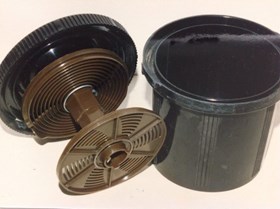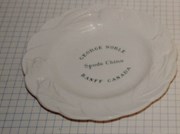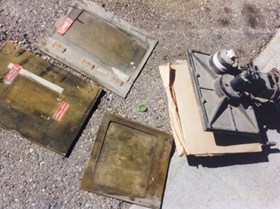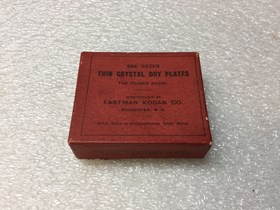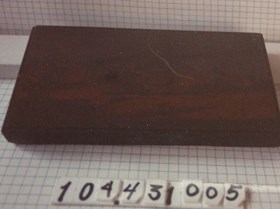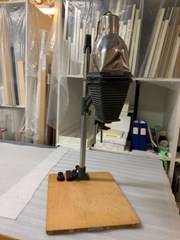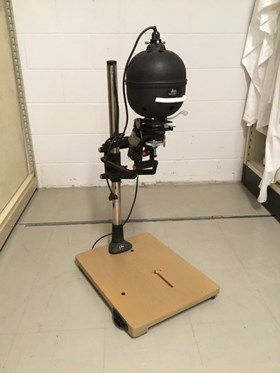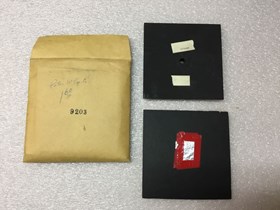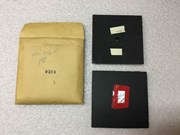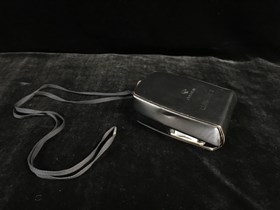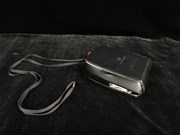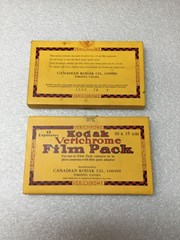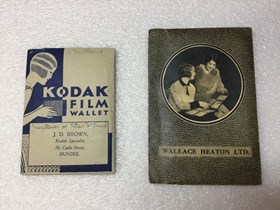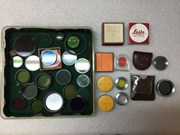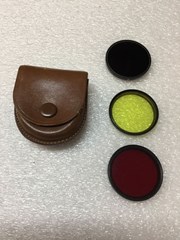Narrow Results By
Developer Liquid Measure
https://archives.whyte.org/en/permalink/artifact104.41.1161
- Date
- 1874
- Catalogue Number
- 104.41.1161
- Description
- A metal 24 ounce measuring jug with handle. The measuring jug has a slight lip for easy pouring. The scale has been inscribed on the inside of the measuring jug and contains both ounces and cubic centimeters or milliliters symbolized by “c.c.” The scale representing ounces begins at 2 ounces and i…
1 image
- Title
- Developer Liquid Measure
- Date
- 1874
- Description
- A metal 24 ounce measuring jug with handle. The measuring jug has a slight lip for easy pouring. The scale has been inscribed on the inside of the measuring jug and contains both ounces and cubic centimeters or milliliters symbolized by “c.c.” The scale representing ounces begins at 2 ounces and increases in 2 ounce increments to 24 ounces. The cubic centimeter scale begins at 100 c.c. and increases in increments of 100 c.c. to 700 c.c. and then by 50 c.c. more to 750. The bottom of the measuring jug has an inscription that reads: “Vollrath” in cursive writing followed by “STAINLESS STEEL WARE” “8324” all in upper case letters. Vollrath is a manufacturer of stainless steel and aluminum parts and products for food service and custom uses.
- Subject
- dark room
- photography
- Nick Morant
- Credit
- Gift of Nicholas Morant, Banff, 2006
- Catalogue Number
- 104.41.1161
Images
This material is presented as originally created; it may contain outdated cultural descriptions and
potentially offensive content.
Read more.
Developing Tank
https://archives.whyte.org/en/permalink/artifact104.41.1059
- Date
- 1930 – 1950
- Material
- plastic
- Catalogue Number
- 104.41.1059
- Description
- Black plastic developing tank; black plastic cylinder with detachable lid; 6 groups of 4 ridges running the height of cylinder; lip surrounding opening at top; "PLANO" printed in relief on lid; 2 oblong holes to correspond to tongues on bottom section; olive colour spool with near spaced thread att…
1 image
- Title
- Developing Tank
- Date
- 1930 – 1950
- Material
- plastic
- Dimensions
- 12.0 x 12.4 cm
- Description
- Black plastic developing tank; black plastic cylinder with detachable lid; 6 groups of 4 ridges running the height of cylinder; lip surrounding opening at top; "PLANO" printed in relief on lid; 2 oblong holes to correspond to tongues on bottom section; olive colour spool with near spaced thread attached to lid with finger knob coming through to outside.
- Subject
- photography
- Credit
- Gift of Robert N. Smith, Canmore, 1985
- Catalogue Number
- 104.41.1059
Images
This material is presented as originally created; it may contain outdated cultural descriptions and
potentially offensive content.
Read more.
- Date
- 1920 – 1940
- Material
- ceramic
- Catalogue Number
- 104.20.1104
- Description
- Small white china plate with a scalloped edge and three tulips and leaves in relief on the rim. The plate has green printing on the face: “George Noble Spode China Banff, Canada” and the Copeland Spode trademark on the bottom.
1 image
- Title
- Dish
- Date
- 1920 – 1940
- Material
- ceramic
- Description
- Small white china plate with a scalloped edge and three tulips and leaves in relief on the rim. The plate has green printing on the face: “George Noble Spode China Banff, Canada” and the Copeland Spode trademark on the bottom.
- Credit
- Purchased from Phyllis Cain, Banff, 1988
- Catalogue Number
- 104.20.1104
Images
This material is presented as originally created; it may contain outdated cultural descriptions and
potentially offensive content.
Read more.
Dry Mounting Press
https://archives.whyte.org/en/permalink/artifact104.41.1067
- Date
- prior to 1950
- Material
- metal
- Catalogue Number
- 104.41.1067
- Description
- Metal press with handle, electrical cord (220). Three brass hinged mounting plates, 3 sizes.
1 image
- Title
- Dry Mounting Press
- Date
- prior to 1950
- Material
- metal
- Description
- Metal press with handle, electrical cord (220). Three brass hinged mounting plates, 3 sizes.
- Subject
- photography
- Byron Harmon
- Credit
- Gift of Don Harmon, Banff, 1994
- Catalogue Number
- 104.41.1067
Images
This material is presented as originally created; it may contain outdated cultural descriptions and
potentially offensive content.
Read more.
- Date
- 1920 – 1940
- Material
- cardboard; paper; glass;
- Catalogue Number
- 104.41.0220
- Description
- Box of one dozen Thin Crystal Dry Plates for a Pocket Kodak camera. The box’s seal has been broken - inside are alternating layers of thin black paper and the glass plates, which are fogged.Dry plate, or the gelatin process, was invented by Dr. Richard L. Maddox in 1871 and replaced the more time-c…
1 image
- Title
- Dry Plates
- Date
- 1920 – 1940
- Material
- cardboard; paper; glass;
- Dimensions
- 1.9 x 6.0 x 5.1 cm
- Description
- Box of one dozen Thin Crystal Dry Plates for a Pocket Kodak camera. The box’s seal has been broken - inside are alternating layers of thin black paper and the glass plates, which are fogged.Dry plate, or the gelatin process, was invented by Dr. Richard L. Maddox in 1871 and replaced the more time-consuming wet plate, or collodion process, which required active wet chemicals to be prepared in mobile dark rooms. The dry plate process underwent several adaptations throughout the 1870s and, in 1879, George Eastman developed a method of applying the emulsion layer to glass in a factory setting, simultaneously creating what came to be known as the Eastman Kodak Co. and bringing down the cost of photography so as to be accessible to the masses.
- Subject
- photography
- photographic equipment
- Credit
- Gift of Catharine Robb Whyte, O. C., Banff, 1979
- Catalogue Number
- 104.41.0220
Images
This material is presented as originally created; it may contain outdated cultural descriptions and
potentially offensive content.
Read more.
Engraving Plate
https://archives.whyte.org/en/permalink/artifact104.43.1005
- Date
- 1930 – 1970
- Material
- wood; metal, copper
- Catalogue Number
- 104.43.1005
- Description
- A rectangle of wood with a metal plate attached. The copper plate has an image on it.This item was transferred to the Archives by SS in May/June 2014.
1 image
- Title
- Engraving Plate
- Date
- 1930 – 1970
- Material
- wood; metal, copper
- Description
- A rectangle of wood with a metal plate attached. The copper plate has an image on it.This item was transferred to the Archives by SS in May/June 2014.
- Subject
- photography
- Credit
- Gift of Arthur Oliver Wheeler, 1975
- Catalogue Number
- 104.43.1005
Images
This material is presented as originally created; it may contain outdated cultural descriptions and
potentially offensive content.
Read more.
- Date
- 1930 – 1950
- Material
- wood; metal; plastic; glass;
- Catalogue Number
- 104.41.0163
- Description
- Metal Kodak Precision Enlarger mounted on a wooden board with power outlets and power switch mounted beside the base of the enlarger. The support arm mostly consists of a silver metal pole onto which the dull grey metal enlarger support is mounted - a plastic knob on one side allows the enlarger su…
1 image
- Title
- Enlarger
- Date
- 1930 – 1950
- Material
- wood; metal; plastic; glass;
- Dimensions
- 105.0 x 44.5 x 55.7 cm
- Description
- Metal Kodak Precision Enlarger mounted on a wooden board with power outlets and power switch mounted beside the base of the enlarger. The support arm mostly consists of a silver metal pole onto which the dull grey metal enlarger support is mounted - a plastic knob on one side allows the enlarger support to move up and down the support arm. The enlarger itself consists of a shiny metal dome with a fabric-wrapped power cord coming out the top [most likely the house for the light source] mounted on top of the grey metal frame [to which the enlarger support is attached] and into which several different negative trays can be fit, below the frame are dark grey fabric bellows that can be adjusted along a set of metal poles, the bottom of the bellows are attached to a smaller grey metal frame that also houses the focussing lens and a coloured filter that can be rotated in and out of frame.
- Subject
- Nicholas Morant
- photography
- photograph equipment
- camera equipment
- darkroom
- photograph developing;
- Credit
- Gift of Nicholas Morant, Banff, 2006
- Catalogue Number
- 104.41.0163
Images
This material is presented as originally created; it may contain outdated cultural descriptions and
potentially offensive content.
Read more.
- Date
- 1920 – 1945
- Material
- wood; metal; glass; plastic;
- Catalogue Number
- 104.41.0170
- Description
- Black and silver metal Leitz negative enlarger mounted on a wooden base. The enlarger consists of an almost round light housing with the power cord coming out from the top - immediately below the globe is a series of plates containing the various filters and lenses, as well as the mounting gear tha…
1 image
- Title
- Enlarger
- Date
- 1920 – 1945
- Material
- wood; metal; glass; plastic;
- Dimensions
- 95.8 x 41.7 x 51.9 cm
- Description
- Black and silver metal Leitz negative enlarger mounted on a wooden base. The enlarger consists of an almost round light housing with the power cord coming out from the top - immediately below the globe is a series of plates containing the various filters and lenses, as well as the mounting gear that attaches the enlarger to the silver metal stand. The enlarger is attached to the stand with adjustable arms and a spring that can be released with a small lever so that the device can be moved closer to or further away from the wooden base.
- Credit
- Gift of Nicholas Morant, Banff, 2006
- Catalogue Number
- 104.41.0170
Images
This material is presented as originally created; it may contain outdated cultural descriptions and
potentially offensive content.
Read more.
- Date
- 1930 – 1960
- Material
- paper; cardboard; wood;
- Catalogue Number
- 104.51.1003
- Description
- Square manilla envelope with one wooden square and one cardboard square with unknown purposes inside. The envelope has “Peter Whyte” written in cursive above “1.60” written in pencil - “9203” is stamped in black in the middle. The wooden square has a hole drilled in the middle and angled edges, mak…
1 image
- Title
- Envelope
- Date
- 1930 – 1960
- Material
- paper; cardboard; wood;
- Dimensions
- 0.5 x 11.9 x 11.9 cm
- Description
- Square manilla envelope with one wooden square and one cardboard square with unknown purposes inside. The envelope has “Peter Whyte” written in cursive above “1.60” written in pencil - “9203” is stamped in black in the middle. The wooden square has a hole drilled in the middle and angled edges, making one side a slightly smaller square than the other, and there are two small pieces of white adhesive tape, one of which has random letters and numbers typed on it [possibly a spacer for a tripod]. The cardboard square has a small hole poked in the middle and blocked off on one side with what appears to be tinfoil taped down with several layers of red adhesive tape.
- Subject
- photography
- Peter Whyte;
- Credit
- Gift of Catharine Robb Whyte, O. C., Banff, 1979
- Catalogue Number
- 104.51.1003
Images
This material is presented as originally created; it may contain outdated cultural descriptions and
potentially offensive content.
Read more.
- Date
- 1933 – 1949
- Material
- plastic; paint; leather; metal; fabric
- Catalogue Number
- 104.41.1123 a-b
- Description
- (a)Gossen Lunasix exposure and colour meter in a pear shape with leather case. The light meter device measures the amount of light that is appropriate to achieve the proper exposure, indicating for the users which shutter speed and f-number should be selected. Along the top of the exposure meter in…
1 image
- Title
- Exposure Meter
- Date
- 1933 – 1949
- Material
- plastic; paint; leather; metal; fabric
- Dimensions
- (a)2.5; (b)04.5 x (a)6.5; (b)7.5 x (a)11.5; (b)12.0 cm
- Description
- (a)Gossen Lunasix exposure and colour meter in a pear shape with leather case. The light meter device measures the amount of light that is appropriate to achieve the proper exposure, indicating for the users which shutter speed and f-number should be selected. Along the top of the exposure meter in the viewer left corner is a white bulb-like part next to an open circular window that measures the amount of light present in the scene. When the converter slide, located along the viewer right side, is moved to the right and clicked into position the round window is open and ready to read the scene. At the top, on the face of the meter, the light measurement (scale) is present. This shows how much light is present in the scene and directly relates to the remaining scales on the meter. Below the light scale is a plexiglass film-speed setting disc with grooves that allow the operator to easily move the dial. In the middle of the dial there is the Lunasix manufacturer symbol. On viewer left side of this emblem is the DIN exposure index of the film in use; on the proper right side of this emblem is the ASA exposure index of the film in use. By moving the dial one adjusts the film-speed setting, which is indicated in the DIN and ASA boxes, whereby the index number is lined up against the triangular white marker in the respective window. A manual would have originally been sold with the object giving a more comprehensive overview of the film-speed table with a technical appendix. On the rear of the object in the viewer right corner one will see the correct position of the 2 batteries indicated through a tiny diagram. Below this is a metal battery chamber. Below this are the words “2 Batt. Mallory” “PX 625 o. PX 13”. To the viewer left of this writing is the ridged slide used for battery testing. Above the ridged slide are the words “Batt. Contr.” with a solid arrow below. Below the battery information is the table of footcandle (LUX) equivalents. In the middle of the table is the zero adjustable screw with an arrow pointing in both directions. AT the very bottom painted on the surface is the location of manufacturing; “GERMANY (WEST)” above a cutout window revealing the patent number; “4D01673”. (b) There is also a black leather case with the object. The inside of the case has gray suede lining, which would have helped avoid scratching and marking of the meter. The case has been carefully designed to retrofit the meter, which is apparent through the tiny leather strap present when the case is opened. These designs allow the object to be formly held into place further safeguarding it. At the bottom of the case there is a black button that allows the case to be opened and fastened shut. When the case is fastened shut, the name of the manufacturer “Gossen” appears imprinted and is upside down. Below this, also upside down, “LUNASIX 3” has been applied in silver ink. Along the viewer right side the case has a cutout that perfectly fit the converter slide. On the rear “MADE IN GERMANY” appears in a receded box with protruding lettering. The bottom of the case, where the button is located, contains an opening for the black string to be strung through. The string, which has been tied to the exposure meter, measures 49.0 cm and has a metal piece holding the ends of the string in place. This would have given the user greater security when working with the exposure meter.
- Subject
- photography
- Nick Morant
- Credit
- Gift of Nicholas Morant, Banff, 2006
- Catalogue Number
- 104.41.1123 a-b
Images
This material is presented as originally created; it may contain outdated cultural descriptions and
potentially offensive content.
Read more.
- Date
- 1930 – 1960
- Material
- cardboard; metal;
- Catalogue Number
- 110.01.0294 a-c
- Description
- Three empty boxes for 16 mm Cine-Kodak Kodachrome and Panchromatic Safety Films. Two boxes have the empty metal film reels inside. The exteriors of the boxes are covered in product and manufacturer details and, on the back, are shipping details for when the film has been developed - two are address…
1 image
- Title
- Film Box
- Date
- 1930 – 1960
- Material
- cardboard; metal;
- Dimensions
- 2.7 x 9.8 x 9.8 cm
- Description
- Three empty boxes for 16 mm Cine-Kodak Kodachrome and Panchromatic Safety Films. Two boxes have the empty metal film reels inside. The exteriors of the boxes are covered in product and manufacturer details and, on the back, are shipping details for when the film has been developed - two are addressed from Peter Whyte in Banff and one is addressed from “MRS PETER WHYTE” in Concord.
- Credit
- Gift of Catharine Robb Whyte, O. C., Banff, 1979
- Catalogue Number
- 110.01.0294 a-c
Images
This material is presented as originally created; it may contain outdated cultural descriptions and
potentially offensive content.
Read more.
- Date
- 1930 – 1980
- Material
- leather; metal; wood; paper
- Catalogue Number
- 104.41.0093 a-h
- Description
- Hard-sided black carry case with a hinged lid and unlined wooden interior. All corners are capped with metal, mostly rusted - three metal latches are also extensively rusted (the centre one is a lock latch). Running along the length of the lid and the bottom of the case are two parallel wooden runn…
1 image
- Title
- Film Case
- Date
- 1930 – 1980
- Material
- leather; metal; wood; paper
- Dimensions
- 22.3 x 21.2 x 62.4 cm
- Description
- Hard-sided black carry case with a hinged lid and unlined wooden interior. All corners are capped with metal, mostly rusted - three metal latches are also extensively rusted (the centre one is a lock latch). Running along the length of the lid and the bottom of the case are two parallel wooden runners. Also on the lid is a hard leather handle attached to the lid with metal loops - attached to both handle loops are several remnants of paper tags and a leather travel tag with a clear plastic window. Visible through the window is a stained paper tag that reads “N Morant Special Photographer Public Relations and Advertising Canadian Pacific Banff, Alberta.” Inside the lid is a “NATIONAL FILM BOARD OF CANADA Exposed Negative” card depicting a woman in a pale green bikini. Drawn on the inside of the lid in black, yellow, and red is a caricature of a face with a thought bubble that reads “AUNT MARTHA LIKES THIS ONE.” The exterior of the case is covered in faded and torn travel stickers and labels, there is also “D7” spray painted in yellow on the lid under the handle, on both short sides, and on the back. Inside the case are three black “KODAK HARD RUBBER TANK 4x5” containers. In one tank are two cardboard boxes - one is green and contains an Eastman timer and the other is a yellow “EASTMAN THERMOMETER” box with the thermometer inside. The second tank contains two circular metal supports for developing rolls of film negatives, a white metal Kodak film canister (empty), and a blue cardboard box with another metal film processor inside. The third tank contains a cylindrical container that has something inside of it, but it does not open.
- Credit
- Gift of Nicholas Morant, Banff, 2006
- Catalogue Number
- 104.41.0093 a-h
Images
This material is presented as originally created; it may contain outdated cultural descriptions and
potentially offensive content.
Read more.
- Date
- 1930 – 1959
- Material
- leather; metal; fabric; wood
- Catalogue Number
- 104.41.0082 a-c
- Description
- Metal developing tanks dimensions: 13.6x11.6x17.2 or smaller.Torn and crinkled label free-floating inside case reads “DALLON SS TANKS 3 1/4 X 4 1/4 24 CAPACITY.” DALLON most likely refers to David Allan (Dallan) sheet metal workers, specializing in darkroom products, of London England. Case is a ha…
1 image
- Title
- Film Developer
- Date
- 1930 – 1959
- Material
- leather; metal; fabric; wood
- Dimensions
- 16.0 x 17.5 x 30.0 cm
- Description
- Metal developing tanks dimensions: 13.6x11.6x17.2 or smaller.Torn and crinkled label free-floating inside case reads “DALLON SS TANKS 3 1/4 X 4 1/4 24 CAPACITY.” DALLON most likely refers to David Allan (Dallan) sheet metal workers, specializing in darkroom products, of London England. Case is a hard-sided black leather box with a lid that hinges open and held open with a brown leather strip on the left-hand side - also has silver metal clasps and carry handle on the front of the case. The case’s interior is lined with grey fabric and the main compartment is divided into two equal sections that house the metal developing tanks. Nailed to the bottoms of each compartment are pieces of wood to prevent the tanks from sliding around. The metal tanks have lids that lift off - one has notches that could have been used to latch the lid down, but no latches remain, and the other has holes in the middle of the lid from where a handle used to be, the handle is missing. Inside the tanks are cradles with lifting handles at either end and removable curved brackets to mount the film in. One tank has what appears to be a vent with a cap on one end, the cap appears to be stuck in place. Folded-up newspaper packed into empty spaces of case beside the tanks, removed.
- Credit
- Gift of Nicholas Morant, Banff, 2006
- Catalogue Number
- 104.41.0082 a-c
Images
This material is presented as originally created; it may contain outdated cultural descriptions and
potentially offensive content.
Read more.
Film Magazine Case
https://archives.whyte.org/en/permalink/artifact104.41.0085
- Date
- 1920 – 1940
- Material
- leather; fabric; metal; paper
- Catalogue Number
- 104.41.0085
- Description
- Black hard-sided leather case with a hinged lid that clasps shut with two metal clasps on either side of a metal hinge lock and metal corner braces. There are two metal bases attached to the lid where a handle may have been attached, handle missing. Faded leather strap is attached with metal clasps…
1 image
- Title
- Film Magazine Case
- Date
- 1920 – 1940
- Material
- leather; fabric; metal; paper
- Dimensions
- 27.7 x 34.1 cm
- Description
- Black hard-sided leather case with a hinged lid that clasps shut with two metal clasps on either side of a metal hinge lock and metal corner braces. There are two metal bases attached to the lid where a handle may have been attached, handle missing. Faded leather strap is attached with metal clasps to rings mounted on both short sides of the case. There is a small square sticker, possibly a travel marker from Mexico, on the left-hand short side under the clasp. In the middle of the lid is a rectangular Canadian Pacific label that has “Film Case” written in black ink and a stamped “PROPERTY OF NICHOLAS MORANT BANFF, ALBERTA” in blue ink. Attached with a short piece of white string to the right-hand carry strap clasp is a paper Canadian Pacific tag that has something written in black ink that is badly damaged by water. A cataloguer tag is also attached to that clasp with “MORANT COLLECTION (film magazines)” written on it in black ink.The interior of the box is lined with a dark red fabric, possibly velvet and is divided into two compartments, the left one slightly larger than the right. The interior of the lid is also divided into two compartments that close off with snaps - small leather pull tabs allowed the compartments to be accessed. There are no manufacturer’s marks on the case. Found inside are three different film magazines.
- Credit
- Gift of Nicholas Morant, Banff, 2006
- Catalogue Number
- 104.41.0085
Images
This material is presented as originally created; it may contain outdated cultural descriptions and
potentially offensive content.
Read more.
- Date
- 1920 – 1940
- Material
- metal; leather; plastic; celluloid
- Catalogue Number
- 104.41.0086 a-c
- Description
- Three black metal and leather “GRAFLEX CUT FILM MAGAZINE,” used to store individual celluloid negatives mounted into individual sleeves housed inside the main body. Access to the main body is possible by removing the the thin back panel with a leather strap that slides up alongside the leather bag …
1 image
- Title
- Film Magazines
- Date
- 1920 – 1940
- Material
- metal; leather; plastic; celluloid
- Dimensions
- 11.0 x 3.5 x 6.5 cm
- Description
- Three black metal and leather “GRAFLEX CUT FILM MAGAZINE,” used to store individual celluloid negatives mounted into individual sleeves housed inside the main body. Access to the main body is possible by removing the the thin back panel with a leather strap that slides up alongside the leather bag as well by pressing a button on the edge opposite the leather bag, allowing the front panel to pop open. On the front panel that can pop off is a small peephole accessible by a spring-hinged cover. Two of the magazines, marked with a red and a white strip of fabric, have the front panels taped closed with a small piece of masking tape.The three magazines are meant for different kinds of film. The one marked with a small strip of green fabric is meant for “KODAK EXTACOLOR Professional Type S (Short Exposure),” the one marked with the red fabric is meant for “KODAK EKTACHROME Film 6116, Type B (Process E-3),” and the one marked with the white fabric is meant for “KODAK TRI-X PAN SHEET FILM (ESTAR Thick Base).” The individual slides housed inside the magazine with the green fabric may have unprocessed fogged negatives still in them.
- Subject
- Nicholas Morant
- photography
- Kodak
- film photography
- photo developing
- Canadian Pacific Railway
- Credit
- Gift of Nicholas Morant, Banff, 2006
- Catalogue Number
- 104.41.0086 a-c
Images
This material is presented as originally created; it may contain outdated cultural descriptions and
potentially offensive content.
Read more.
- Date
- 1938 – 1945
- Material
- cardboard;
- Catalogue Number
- 104.41.0204 a,b
- Description
- Two boxes of 12 10x15cm Kodak Verichrome Film Packs with broken seals. Each box is mostly yellow with black and red manufacturer and product details throughout - there are two paper adhesive stickers holding the box closed, the one that has the expiration date on it on each box is broken.Verichrome…
1 image
- Title
- Film Pack
- Date
- 1938 – 1945
- Material
- cardboard;
- Dimensions
- 1.4 x 17.9 x 10.9 cm
- Description
- Two boxes of 12 10x15cm Kodak Verichrome Film Packs with broken seals. Each box is mostly yellow with black and red manufacturer and product details throughout - there are two paper adhesive stickers holding the box closed, the one that has the expiration date on it on each box is broken.Verichrome was a kind of panchromatic film that yielded high-quality black and white photographs thanks to the fine-grained emulsion. Film Packs were basic forms of storage meant to be used shortly after purchasing as their [mostly] paper packaging did not keep out oxygen well and had a tendency to fog over time, rendering the film unusable in the long term. It was replaced by the more stable Verichrome Pan in the 1950s.
- Credit
- Gift of Robert Crosby Family, Banff, 1998
- Catalogue Number
- 104.41.0204 a,b
Images
This material is presented as originally created; it may contain outdated cultural descriptions and
potentially offensive content.
Read more.
Film Strip Projector
https://archives.whyte.org/en/permalink/artifact105.05.1015
- Date
- c. 1930
- Material
- metal; paper; glass
- Catalogue Number
- 105.05.1015
- Description
- 35 mm film strip projector and case. Simple design projector having rectangular metal base with manufacturer's nameplate. Tower one side of rectangle, housing a bulb. Chrome assembly attached to front of tower concealing first lens, second lens is detachable, rolled in handkerchief. Cylindrical sec…
1 image
- Title
- Film Strip Projector
- Date
- c. 1930
- Material
- metal; paper; glass
- Dimensions
- 21.8 x 15.3 x 21.3 cm
- Description
- 35 mm film strip projector and case. Simple design projector having rectangular metal base with manufacturer's nameplate. Tower one side of rectangle, housing a bulb. Chrome assembly attached to front of tower concealing first lens, second lens is detachable, rolled in handkerchief. Cylindrical section for the insertion of lens, curled flat chrome piece for holding filmstrip, gearing with knob, for advancing strip to next frame. Maroon electric cord coming from back. Black box made of cardboard with red felt inside. Bucket on front for locking. Leather carrying handle. Small box of slide labels marked "Ingram & Bell Ltd.".
- Subject
- photography
- Hubert Green
- Credit
- Gift of Hubert E. Green Jr., Banff, 1986
- Catalogue Number
- 105.05.1015
Images
This material is presented as originally created; it may contain outdated cultural descriptions and
potentially offensive content.
Read more.
- Date
- 1930 – 1931
- Material
- paper;
- Catalogue Number
- 104.41.0219 a,b
- Description
- Two paper folding envelopes for holding film and/or developed prints - one is Kodak and one is from Wallace Heaton Ltd., a developing studio in London England. Both wallets fold open to show two open-sided pouches where either films or prints could be slotted and have advertising for other services…
1 image
- Title
- Film Wallet
- Date
- 1930 – 1931
- Material
- paper;
- Dimensions
- 0.3 x 11.3 x 16.7 cm
- Description
- Two paper folding envelopes for holding film and/or developed prints - one is Kodak and one is from Wallace Heaton Ltd., a developing studio in London England. Both wallets fold open to show two open-sided pouches where either films or prints could be slotted and have advertising for other services/products printed on them. The Kodak wallet is predominantly white and blue, has a small slip of paper that appears to have “13/5/30 [?] Winton” and several numbers written on it in pencil, several numbers written in pencil on the left-hand side inside, and “Scotland / Negatives of Pete’s Scotland” written in black ink by Catharine Whyte on the front cover. The Wallace Heaton wallet is predominantly grey and black with a picture of two women looking at a photo album on the front cover, a slip of paper that appears to be a receipt for the Browns Hotel made out to “Nice Esq” tucking inside, “Scotland / Nice Esq / egative Scotland 1930” written in different hands on the back [everything except “Nice Esq” written by Catharine Whyte].
- Credit
- Gift of Catharine Robb Whyte, O. C., Banff, 1979
- Catalogue Number
- 104.41.0219 a,b
Images
This material is presented as originally created; it may contain outdated cultural descriptions and
potentially offensive content.
Read more.
- Date
- 1930 – 1970
- Material
- plastic; fabric; felt; leather; glass; cardboard;
- Catalogue Number
- 104.41.0212
- Description
- Square clear plastic box lined with green felt containing 26 camera filters and 2 lens caps - 6 filters are in various containers, one is unopened. Most filters were manufactured by Leitz Wetzler [the company changed its name to Leica in 1986], some are Kodak, and two are Zeiss. Filters include yel…
1 image
- Title
- Filter Box
- Date
- 1930 – 1970
- Material
- plastic; fabric; felt; leather; glass; cardboard;
- Dimensions
- 3.8 x 23.2 x 23.2 cm
- Description
- Square clear plastic box lined with green felt containing 26 camera filters and 2 lens caps - 6 filters are in various containers, one is unopened. Most filters were manufactured by Leitz Wetzler [the company changed its name to Leica in 1986], some are Kodak, and two are Zeiss. Filters include yellow, orange, red, blue, tinted, and clear patterned glass.
- Credit
- Gift of Catharine Robb Whyte, O. C., Banff, 1979
- Catalogue Number
- 104.41.0212
Images
This material is presented as originally created; it may contain outdated cultural descriptions and
potentially offensive content.
Read more.
- Date
- 1930 – 1970
- Material
- metal; glass; leather;
- Catalogue Number
- 104.41.0216
- Description
- Three colour tinted Leica lens filters in a snap-closed leather pouch - one filter is red, one yellow, one very dark red [looks black without a light behind it].
1 image
- Title
- Filter Lens
- Date
- 1930 – 1970
- Material
- metal; glass; leather;
- Dimensions
- 2.4 x 5.8 x 6.6 cm
- Description
- Three colour tinted Leica lens filters in a snap-closed leather pouch - one filter is red, one yellow, one very dark red [looks black without a light behind it].
- Credit
- Gift of Catharine Robb Whyte, O. C., Banff, 1979
- Catalogue Number
- 104.41.0216
Images
This material is presented as originally created; it may contain outdated cultural descriptions and
potentially offensive content.
Read more.



